
- Home
- Welcome to GunLoads.com
 Main Menu» Home
Main Menu» Home
» Reloading Shop
» Reviews
» Staff Reviews
» Member Reviews
» Reloading
» Pistols
» Rifles
» Shotguns
» Printable Targets
» Rifle
» Pistol
» Sniper
» Fun
» Animal
» Load Sheets
» Tips & Safety
» Gun Safety
» Reloading Tips
» Community
» Gallery
» Hunting Seasons
» Forums
» Submit News
» Clothing Store
» Hunting Videos
» Others
» Link To Us
» Feedback
» Recommend Us
» Photo Hosting
» Donations GunLoads Hosted Sites
GunLoads Hosted Sites Our GoalOur goal is to bring you everything you need to accurately reload your own weapon of choice, along with all the accessories to go with it. Including, free printable targets, tips, safety instructions and of course gun loads.This site is going to be as much member run as possible. With member reviews, stories, and creativity! Thanks and enjoy your stay.
Our GoalOur goal is to bring you everything you need to accurately reload your own weapon of choice, along with all the accessories to go with it. Including, free printable targets, tips, safety instructions and of course gun loads.This site is going to be as much member run as possible. With member reviews, stories, and creativity! Thanks and enjoy your stay.
LenKaiser
by Published on 10-16-2014 09:30 AM Number of Views: 868
Gun Type: .17 Mach 2
Firearm Type: Pistol
Accuracy Rating: 5
Caliber Type: test
Lead Type: testing
Lead Size: 150
Powder Type: test
Powder Amount: testing
Primer: test
Brass: tester
Barrel Length: 6
F.P.S.: test
Group Size: tester
Overall Length: test
Gun Details:
Lorem ipsum dolor sit amet, consectetur adipiscing elit. Nunc fringilla lorem non rutrum maximus. Quisque laoreet ultricies risus, id vehicula lectus rutrum at. Maecenas vitae nisl ac arcu dictum commodo quis ac justo. Pellentesque eget rutrum tortor. Quisque sit amet blandit lorem. Nulla cursus, dui quis ultrices porta, elit tortor tristique ipsum, quis lobortis diam mauris a purus. Donec at nunc leo. Aliquam condimentum ornare rhoncus. Nullam gravida pretium finibus. Quisque nec porta ex, quis tristique sem. Sed blandit, arcu a porttitor facilisis, nisi magna euismod dolor, interdum tristique leo turpis nec odio. Sed dictum nisl id sollicitudin congue. Etiam euismod, lectus sit amet tincidunt dictum, magna quam fermentum mi, a facilisis justo nisl a urna. Integer id consectetur arcu, interdum mattis velit.
Mauris imperdiet lacus quis eros finibus gravida. Duis interdum sagittis enim non imperdiet. Vestibulum ultricies neque luctus, rutrum mauris eu, varius ipsum. Aenean consequat a nulla porta condimentum. Sed egestas quis elit ac condimentum. Vivamus et eros et mi porttitor mollis id vel magna. Phasellus mollis ut neque a efficitur. Curabitur ultrices massa quis neque lobortis ornare. Mauris auctor odio id ipsum dapibus, non maximus diam dapibus. Nullam fringilla commodo lectus, ut commodo turpis iaculis ac. Praesent non aliquam odio. Sed vitae bibendum mi. Fusce commodo nisl vitae elit vehicula, vitae interdum felis gravida. Curabitur efficitur semper felis, vitae luctus tortor rutrum commodo.
Integer auctor pulvinar scelerisque. Praesent varius urna est, id egestas mauris auctor aliquet. Phasellus aliquet ultricies ex quis ornare. Aliquam nec purus eu erat dignissim rutrum. In bibendum porttitor dui, et hendrerit nulla sagittis quis. Donec ut purus vitae eros dignissim auctor sed in ipsum. Nullam interdum leo sed condimentum mollis. Pellentesque condimentum eu lectus sed condimentum. Nullam iaculis porta turpis, bibendum dapibus lectus dignissim vitae. Duis eget neque a lorem euismod hendrerit eu ut mauris. Nam ornare augue vitae semper commodo. Etiam imperdiet justo eu dolor rutrum, et condimentum nisl vestibulum.
Lorem ipsum dolor sit amet, consectetur adipiscing elit. Interdum et malesuada fames ac ante ipsum primis in faucibus. Nulla blandit ac arcu vel rutrum. Nullam porta blandit nisl, id congue velit sagittis eget. Praesent eget accumsan justo. Aenean non sollicitudin ligula. Donec eleifend congue imperdiet. Duis tristique, tellus non laoreet sagittis, ipsum arcu pretium nibh, eu tristique tortor lectus eget justo. In finibus lacus non odio consequat, vel sodales sem viverra. Nullam fringilla accumsan eros, interdum rutrum dolor auctor eu. Aenean sit amet tortor commodo, ullamcorper ipsum sed, ullamcorper lectus. Aliquam euismod sagittis dui et aliquam. Morbi vehicula auctor diam, volutpat condimentum orci rutrum et.
Ut consequat velit eget enim lobortis tincidunt. Suspendisse in dapibus diam, quis consectetur turpis. Curabitur et nunc a risus placerat cursus. Donec tempor ligula et nulla iaculis, ut sagittis sem vestibulum. Aliquam egestas cursus nunc, ac maximus risus mattis quis. Aliquam in porttitor dolor. Sed ultricies, tortor eu convallis lobortis, nisl ligula eleifend est, id ullamcorper nisi dui eget enim. Nullam commodo varius venenatis. Fusce commodo placerat magna, vel efficitur massa eleifend at. Curabitur bibendum, felis quis egestas pulvinar, est augue aliquam diam, vel laoreet orci sapien sed tortor. Mauris pretium tempor nisi.
Other Description:
Lorem ipsum dolor sit amet, consectetur adipiscing elit. Nunc fringilla lorem non rutrum maximus. Quisque laoreet ultricies risus, id vehicula lectus rutrum at. Maecenas vitae nisl ac arcu dictum commodo quis ac justo. Pellentesque eget rutrum tortor. Quisque sit amet blandit lorem. Nulla cursus, dui quis ultrices porta, elit tortor tristique ipsum, quis lobortis diam mauris a purus. Donec at nunc leo. Aliquam condimentum ornare rhoncus. Nullam gravida pretium finibus. Quisque nec porta ex, quis tristique sem. Sed blandit, arcu a porttitor facilisis, nisi magna euismod dolor, interdum tristique leo turpis nec odio. Sed dictum nisl id sollicitudin congue. Etiam euismod, lectus sit amet tincidunt dictum, magna quam fermentum mi, a facilisis justo nisl a urna. Integer id consectetur arcu, interdum mattis velit.
Mauris imperdiet lacus quis eros finibus gravida. Duis interdum sagittis enim non imperdiet. Vestibulum ultricies neque luctus, rutrum mauris eu, varius ipsum. Aenean consequat a nulla porta condimentum. Sed egestas quis elit ac condimentum. Vivamus et eros et mi porttitor mollis id vel magna. Phasellus mollis ut neque a efficitur. Curabitur ultrices massa quis neque lobortis ornare. Mauris auctor odio id ipsum dapibus, non maximus diam dapibus. Nullam fringilla commodo lectus, ut commodo turpis iaculis ac. Praesent non aliquam odio. Sed vitae bibendum mi. Fusce commodo nisl vitae elit vehicula, vitae interdum felis gravida. Curabitur efficitur semper felis, vitae luctus tortor rutrum commodo.
Integer auctor pulvinar scelerisque. Praesent varius urna est, id egestas mauris auctor aliquet. Phasellus aliquet ultricies ex quis ornare. Aliquam nec purus eu erat dignissim rutrum. In bibendum porttitor dui, et hendrerit nulla sagittis quis. Donec ut purus vitae eros dignissim auctor sed in ipsum. Nullam interdum leo sed condimentum mollis. Pellentesque condimentum eu lectus sed condimentum. Nullam iaculis porta turpis, bibendum dapibus lectus dignissim vitae. Duis eget neque a lorem euismod hendrerit eu ut mauris. Nam ornare augue vitae semper commodo. Etiam imperdiet justo eu dolor rutrum, et condimentum nisl vestibulum.
Lorem ipsum dolor sit amet, consectetur adipiscing elit. Interdum et malesuada fames ac ante ipsum primis in faucibus. Nulla blandit ac arcu vel rutrum. Nullam porta blandit nisl, id congue velit sagittis eget. Praesent eget accumsan justo. Aenean non sollicitudin ligula. Donec eleifend congue imperdiet. Duis tristique, tellus non laoreet sagittis, ipsum arcu pretium nibh, eu tristique tortor lectus eget justo. In finibus lacus non odio consequat, vel sodales sem viverra. Nullam fringilla accumsan eros, interdum rutrum dolor auctor eu. Aenean sit amet tortor commodo, ullamcorper ipsum sed, ullamcorper lectus. Aliquam euismod sagittis dui et aliquam. Morbi vehicula auctor diam, volutpat condimentum orci rutrum et.
Ut consequat velit eget enim lobortis tincidunt. Suspendisse in dapibus diam, quis consectetur turpis. Curabitur et nunc a risus placerat cursus. Donec tempor ligula et nulla iaculis, ut sagittis sem vestibulum. Aliquam egestas cursus nunc, ac maximus risus mattis quis. Aliquam in porttitor dolor. Sed ultricies, tortor eu convallis lobortis, nisl ligula eleifend est, id ullamcorper nisi dui eget enim. Nullam commodo varius venenatis. Fusce commodo placerat magna, vel efficitur massa eleifend at. Curabitur bibendum, felis quis egestas pulvinar, est augue aliquam diam, vel laoreet orci sapien sed tortor. Mauris pretium tempor nisi.by Published on 10-15-2014 01:15 PM Number of Views: 19592Published on 10-15-2014 01:08 PM Number of Views: 20629~By Capt Walt
I needed a Big Game rifle for my son that was capable of taking whitetailed deer, Black Bear and Moose but it had to be easy to handle, low recoil, reliable and affordable for the young shooters first big game rifle as well as classy enough for any shooter with fine taste.
Priced at $775.00 at Maines largest gun dealer it is an exceptional value for the money.
This is an American made rifle with its history dating back to the time of the Civil War, or the war of insurection for folks south of the Mason Dixon line.
When President Lincon was seeking any advantage to help the union win the war; a newly invented idea was presented to him. The Henry Lever action repeating rifle.
It was the first of its kind to be produced with other gun manufactures taking to the idea and producing there own versions the lever action it played an important part in helping the Union win the war and was part of the our countries history of how the west was won. To this day cowboy re-inactors use the Henry as part of their authentic getup for events.
This rifle not only looks good with its Solid top brass receiver, brass buttplate and brass barrel band it hits the nail right on the head staight out of the box. With standard adjustable Marble semi-buckhorn rear with white diamond insert and brass beaded front sight I have the feeling that Henry takes care to make sure that this rifle will pop bullseyes at 50 yrds and 100 yards without a lot of trial and error.
The tube magazine holds an amazing amount of bullets; more than most hunters will ever need. Henrys motto was quoted form old Honest Abe "Load on Sunday, Shoot all week long"
The guns powerful bullet selection will take down any game animal in North America.
Safe shooting practice is enhanced in that the tube design must be loaded with the reciever chamber open. Dont forget to lever it clear when loading! This safety procedure makes the lever action an exceptionally safe design as you can show clear.
Weighing in at 8.68 lbs this isn't the lightest lever action rifle made but the extra heft goes a long way in absorbing recoil of even the roaring 240 gr. Super-X® Hollow Soft Point loads.
Unlike many short lever action hunting rifles that kick like a mule this Henry tends to roll with the punch more like a shotgun, Certainly a big plus for all hunters.
The quality of materiels and workmanship is top notch with excellent fit and finish of both machine parts and good quality wood stocks. This rifle ejects on the right hand side with a nice downward case throw making it a good choice for both right handed shooters and southpaws. I especally like being able to retreive the brass without looking all over for them. A good feature for reloaders. The action was smooth and functioned flawlessly from the first shot. Its getting even better after shooting a few hundred rounds and cleaning out all of the packing grease.
The pride in craftsmanship is displayed in all dealiungs with the Henry company. They treat Evey customer like you are their most important. That kind of service is exceptional in todays market.
This rifle like all high tolerance fine machined tools works well lubricated with a very low viscosity machine/gun oil. The rifle was tested in below freezing weather in coastal Maine in December with salt spray in the air. Not the kindest enviourment for any hunting equipment and certainly a vigourous testing ground for a Deer Rifle.
My 12 yr old son used winchester 240 gr. USA Jacketed Soft Point ammo for his first try on using a large caliber rifle and did as well as if he was shooting his .22 bolt action. Having used this Henry .44 Mag makes me wish that I also had their .22 lever action for small game and plinking. This rifle is one that will give a lifetime of hunting service and can be carried by shooters of all ages. Few firearms these days fall into the Hierloom category as well as being serviceable hunting weapons. This Henry rifle meets a lot of requirements in a fairly priced package.
My only regret is that I had not shot one a long time ago.
Capt Walt
Master Maine Guide, New England Charters & Guide Service LLC
by Published on 10-15-2014 01:04 PM Number of Views: 19667by Published on 10-15-2014 12:51 PM Number of Views: 24185by Published on 10-15-2014 12:36 PM Number of Views: 19416Published on 10-15-2014 12:00 PM Number of Views: 19920Call them what you will: peep sights, receiver sights, or aperture sights. I will use the terms interchangeably herein for easier reading. However you choose to describe them, you ought to consider trying one on your hunting rifle.
Now, I’m sure the purists will want to pick nits and say that each term has a distinct meaning and I won’t argue it as there are many different variations on the basic design, but what I’m talking about here is looking through a small round hole very close to your eye at a flat-topped post front sight on which sits your target.
Using aperture sights is simple. Pick up the rifle, put the target on the front sight, and press the trigger. The aperture, close to your eye, becomes almost invisible when you look through it, a “ghost ring” in which your eye automatically centers the front sight. With very little practice, complex motion becomes a learned reflex and you no longer have to think about it. You just do it. Fast. Simple.
How They Work
How they work is a little more complicated, but still not rocket science. The human eye has a lot of things in common with the camera with which we can draw useful parallels, so let’s start there. The f-stop on a camera is a variable aperture behind the camera’s lens that allows you to regulate the amount and angle of the light that passes through the lens and onto the film or photo-receptor in a digital camera. With the f-stop opened wide, you have little depth of field, and you have to choose what part of the frame will be in focus. Likewise with your eye under normal daylight conditions, you have to focus back and forth to see objects at differing distances clearly. Young eyes can do this almost without effort, and it’s easy to look from the front to the rear sight to the target, etc. It gets harder and slower as your eyes age, however.
But when you change the camera’s f-stop to a smaller-sized opening, you narrow the path of the light, eliminate the peripheral light, and you increase the depth of field. Things both near and far are in focus at the same time. Think about the simplest pinhole cameras. Every single element of the image is in sharp focus, regardless of its relative distance from the camera.
With your shooting eye, this means that by narrowing the available light and increasing the depth of field, you don’t have to keep refocusing back and forth between sights and target. They’re both in focus at the same time. As I said, the older you get, the harder it is and the longer it takes to change focus. The immediate advantages of this are readily apparent.
There’s even a way to make use of this principle with open sights, too. Punch a small round hole in a piece of black electrical tape and stick it on the lens of your shooting or prescription glasses over your shooting eye. It’s not magic. Really. It just seems that way when you try it. Merit and other companies make a tiny variable aperture that attaches with a tiny suction cup to the lens of your prescription or shooting glasses: simple, elegant perfection for target shooting.
The fanciest versions of peep sights can be found on match rifles. Target shooters love them for their repeatable micrometer adjustments and because they have the option of screw-in inserts with differing aperture sizes for different ranges and targets. To complement them are a wide variety of matching globe front sights with their own interchangeable reticule-like inserts. Some even have spirit levels for consistent holds. Incredibly precise, they’re much too slow to be of any use hunting, though a fascinating topic to read up on nonetheless.
Using Peep Sights
But this is an article about hunting rifles. While the advantages of putting receiver sights on your hunting rifle are numerous, they’re not for every situation. Here in New Hampshire, most shots we get at deer, bear, or moose are between 25 and 75 yards. The woods are thick, though sometimes you can find yourself in a field or a sizeable clearcut. Still, 150 yards is a really long shot here, but well within the effective range of peep sights. In other parts of the country, hunting in bean fields, prairies, or canyons and shooting at ranges between 200 and 500 yards, don’t throw away your scope. At those ranges, you’ll likely have plenty of time and your quarry probably won’t know you’re there. Thick cover and fast shots at close ranges aren’t unique to New England, however, and maybe you can make use of some old Yankee know-how for hunting Texas javelina or Montana mulies. Truth to tell, most anyone who learned how to shoot before scopes grew up and left the target ranges for the hunting fields could teach you more than a few things about them. When they do, you should listen. You can never learn too much about something you enjoy.
So, what’s so great about peep sights? Well, to start with, when you use peep sights you get to keep both your eyes open, and retain your depth perception - not the same as depth of field. I’m talking about the ability to tell how far away from you something is, which would otherwise be lost if you were using only one eye. Witness the success, variety, and popularity of red-dot optical sights.
Peep sights are extremely fast to use, especially on moving targets, because you don’t focus on the rear sight. Just swing the rifle, put the deer on top of the post, and press the trigger. Even with them, you will always be more accurate with as solid a rest as you can find handy, especially for shooting longer distances. But sometimes when you’re in the brush and the deer start jumping, you have to snapshoot. The ranges are never long, but you definitely don’t have time to be squinting at your sights and trying to focus. I think that’s one reason so many hunters “climb up the rifle” and shoot high when they have to get a shot off quickly in thick cover: trying to see over the blurry buckhorn rear sight that keeps getting in the way of fast target acquisition and tracking. Don’t even think about trying to use any kind of a scope in such a situation, the deer will be in the next county before you can get off a shot.
Aperture sights are very accurate, both because they create a longer sight radius mounted on the receiver than traditional barrel-mounted open sights, and because they give you a consistent sight picture for every shot.
They cannot be beat in low light situations. Where you’d lose a thinner front sight in shadow, the wide, flat post remains clearly visible. You don’t really see the “ghost ring”, but your eye reflexively centers the top of the post in it. Open rear sights vanish when you enter timber shadows on a sunny day, and it can take anywhere from a few seconds to a minute or more for older eyes to adjust to sudden changes in lighting. In the early morning and late evening, when you can see neither open sights nor unlighted scope reticules, peep sights will give you those precious extra minutes when the game is often on the move.
Once their rifles are sighted in, most hunters will opt to remove the screw-in inserts from their receiver sights for greater visibility and faster speed of target acquisition with the larger hole, and most usually use them with a flat-topped post. A similar system with large holes (minus the inserts) is found on many military rifles, and also on some slug shooting shotguns for much the same reasons.
All of my deer rifles except one, a scout rifle, are equipped with peep sights. My trusty old bolt action Remington 788 in .308 wears a Williams receiver sight with a handmade custom brass front post. My muzzleloader, an older Thompson/Center Renegade with a Green Mountain drop-in barrel in .54 cal. wears one of T/C’s excellent tang-mounted versions. Last, but not least, my cast boolit rig, a T/C Contender Carbine in .30-30 wears a T/C peep sight.
My small game rifle, a Ruger 10/22, wears a Williams sight, too, though it needed to have a taller front sight installed. My local gunsmith found both in Brownells and ordered them for me. This particular front sight has a round gold bead instead of my preferred post, but as it’s seldom used in low light situations, I’m happy with it as it is. No squirrel, raccoon, or woodchuck has ever stopped to complain about it. When I have screwed the small-holed aperture back into the sight, it has easily held its own against anything in its class at local charity and turkey shoots.
One can find other makers of receiver sights, some still in production, while others are a gun show only find. Some names that come to mind besides Williams and T/C are Lyman, Winchester, Redfield, and Marbles. I’m sure there are more, too.
One company, NECG (New England Custom Gun Services), now makes emergency peep sights that mount easily onto Weaver or Ruger scope bases.
Not so many new rifles today come already drilled and tapped for them from the factory, but most older used rifles are. At one time, such sights were factory options on many single shot and lever action rifles, and there were numerous aftermarket tang-mounted fold-down post sights available. Even if your current rifle isn’t drilled and tapped, it’s a simple and inexpensive job for your local gunsmith, and it’s even a reasonably easy project with the right jig for the amateur. It’s a good excuse for a pleasant hour or two of wandering through the Brownells catalog looking at tools and sights, either way.
Practice, Practice, Practice
Now, when you’ve got the sight properly mounted onto your rifle, remember that there is a little more to it than just sighting it in from the bench and heading off into the woods. If you’ve done much shooting of military rifles like M1 Carbines, Garands, AR-15/M-16s, etc., it won’t take much to get comfortable with the system. But if you haven’t, do get yourself down to the range and practice: offhand, sitting, and making use of natural rests.
You really need to be shooting at least a box of ammo each range session, and more is better. Weekly visits to the range for several months before hunting season isn’t at all excessive, no matter what kind of sights are on your rifle. The truth is, most hunters are not target shooters and very few hunters practice anywhere near enough to shoot at their own potential, never mind that of their trusty rifle. Ask yourself this: What is the maximum distance you can put five rounds offhand into an eight inch circle (the size of a deer’s “kill zone”, the “pieplate test”) with your deer rifle? Can you do it at 200 yards? 100 yards? Only 50 yards? An honest appraisal of our own skills at the range is often enough to convince us of our need for more practice.
Shooting off the bench makes for smaller groups, but doing only bench shooting won’t help you at all in the field. I will admit that certain knowledge of what your rifle and load is capable of doing can boost your confidence, but there is no substitute for regular practice from a variety of positions. Usually, one shot is all you’ll get, so you have to do it right the first time. Lots of realistic practice will help you make that one shot count. Ranges with running game targets are almost as rare as Bigfoot, but if you have one near you, by all means go for it. Taping targets to old tires and rolling them down a hill and other similarly creative ideas will work, too, if you give some careful thought to how you can do it safely. Shooting at reactive targets, metal gongs, or silhouettes at random distances can be fun, too – turn your back while a friend moves them around, then when you’re told it’s safe, turn and shoot at them.
Don’t forget about your .22! In fact, it should be the first rifle for you to try peep sights on. The ammo’s much cheaper, it’s lots of fun, and you’ll shoot it a lot more. Then, when you’ve gotten comfortable shooting it on the range, take it out after some speedy little red squirrels to get ready for deer or bear season. When you can hit one of the little buggers at 50 yards, a deer at 100 looks huge and easy to hit. It shouldn’t take very long for you to see the light and put a set on your big game rig, too. You won’t regret it.
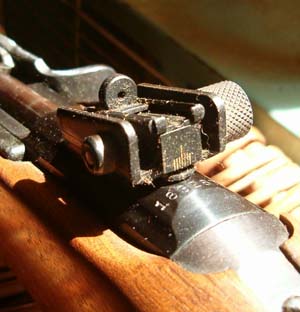
001 The M1 Carbine rear sight is very rugged and fully adjustable.
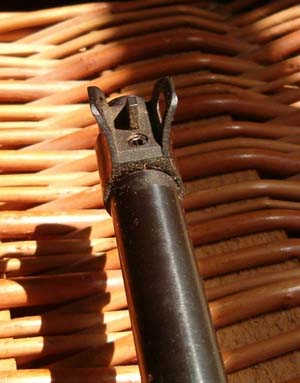
002 The M1 Carbine front sight post is protected by two steel “wings”.
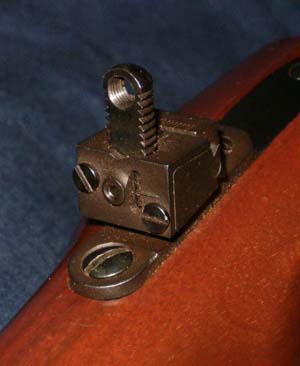
003 This is Thompson/Center’s tang-mounted rear sight on a Renegade muzzle loader.
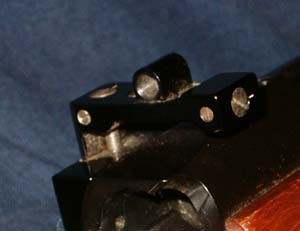
004 Williams FP sight on a Remington 788 action.
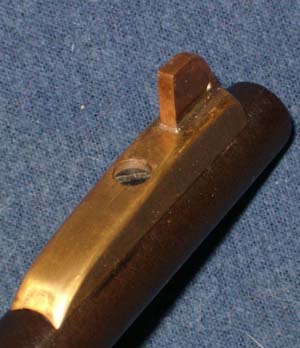
005 A custom brass front post sits atop this Remington barrel.
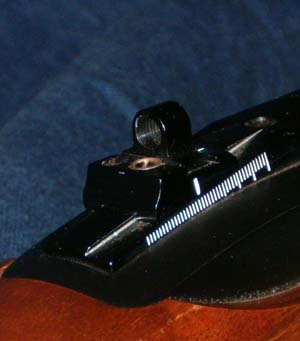
006 Williams GRS on a Ruger 10/22 action.
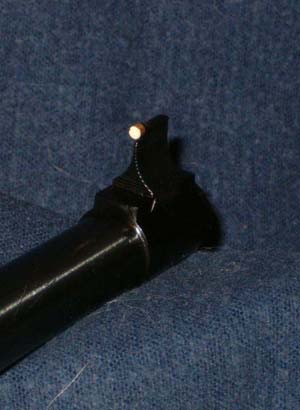
007 Matching Williams front sight on a Ruger 10/22 barrel.
 Last 5 Loads
Last 5 Loads Old Articles
Old Articles
| BP | Bronze Point | IMR | Improved Military Rifle | PTD | Pointed |
| BR | Bench Rest | M | Magnum | RN | Round Nose |
| BT | Boat Tail | PL | Power-Lokt | SP | Soft Point |
| C | Compressed Charge | PR | Primer | SPCL | Soft Point "Core-Lokt" |
| HP | Hollow Point | PSPCL | Pointed Soft Point "Core Lokt" | C.O.L. | Cartridge Overall Length |
| PSP | Pointed Soft Point | Spz | Spitzer Point | SBT | Spitzer Boat Tail |
| LRN | Lead Round Nose | LWC | Lead Wad Cutter | LSWC | Lead Semi Wad Cutter |
| GC | Gas Check |

Copyright © 2024 vBulletin Solutions Inc. All rights reserved.
vBulletin Skins: Len M. Kaiser Web Design








